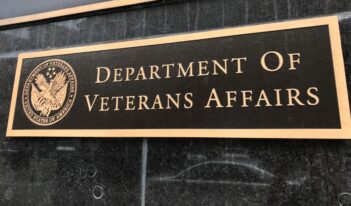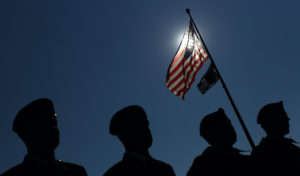
For-profit colleges target U.S. veterans as a source of federal funds.
“They’re trying to swindle and hoodwink you.”
President Barack Obama used those words in 2012 when addressing military members and their families about the deceptive trade practices used by some for-profit colleges. A few years later, then-Assistant Director for Servicemember Affairs at the Consumer Financial Protection Bureau, Holly Petraeus, went so far as to write that for-profit colleges see servicemembers as “dollar signs in uniform.”
The problem that Petraeus and President Obama addressed years ago still persists today. For-profit universities target veterans with aggressive marketing, seeking to profit off of GI Bill tuition benefits and leading military students to take out private loans to cover the difference between what their aid covers and the cost of attending. The Post-9/11 GI Bill provides between 40 to 100 percent of education costs for individuals who served on active duty for more than 90 days any time after September 10, 2001.
For-profit colleges return a significant share of their revenue directly to investors, as opposed to reinvesting it in the institution. Many for-profit schools deceive prospective students with false information to encourage enrollment, including by making misrepresentations about future career prospects. In 2017, for example, for-profit colleges were the object of 98 percent of college fraud claims.
Policymakers have long grappled with how to protect military members from these deceptive practices. When Congress amended the Higher Education Act in 1992, for-profit schools constituted only 20 percent of all student loan debt but almost 50 percent of all loan defaults. In response to accelerating loan defaults by students at for-profit colleges, Congress changed the law to limit the percent of aid those institutions could take from taxpayers.
Under the 90/10 rule, for-profit colleges cannot obtain more than 90 percent of their revenue from federal aid programs. The policy was meant to push for-profit colleges to seek students who would pay for programs on their own, which would encourage schools to maximize the social value of their programs. Instead of improving their curriculum, for-profit colleges found a loophole.
Benefits under the Post 9/11 GI Bill do not count as federal funds under the 90/10 rule, meaning that for-profit schools can fill the required non-federal 10 percent solely with revenue derived from GI Bill benefits. When the Higher Education Act was amended in the 1990s, the GI Bill was mostly dormant and therefore not included in the Act’s definition of federal aid.
For-profit colleges are primarily interested in veterans because GI Bill funds allow them to circumvent the 90/10 rule. Some researchers explain that federal funds are the “lifeblood” of a for-profit school. This reliance on federal money gives for-profit schools an incentive to market to servicemembers. One veteran reportedly received over 70 phone calls and 300 emails from for-profit colleges within the span of a few days.
Lawmakers have attempted to counteract the incentives created by the 90/10 rule for the better part of the last decade. Others have suggested changing the rule’s ratio to 85/15 and including the Post-9/11 GI Bill within the scope of federal funding. Researchers at the Brookings Institution have estimated that if the 90/10 rule had been changed to 85/15 in 2015, 13 percent of for-profit colleges would have failed. Using an 80/20 rule, the failure rate would have increased to 27 percent.
On Veteran’s Day in 2019, a bipartisan coalition of senators introduced the Protect VETS Act, a bill which would close the 90/10 loophole by counting GI Bill funds as qualified federal aid. A similar bill, the Protect the GI Bill Act of 2019, was passed in the U.S. House of Representatives and includes a ban on deceptive recruiting and more oversight of for-profit colleges. Both bills sat in committee and were never reported to the Senate floor.
In the absence of national reform, last year Maryland became the first state to close the loophole when Governor Larry Hogan approved the Veterans’ Education Protection Act. Like the Protect VETS Act, the Maryland bill requires that for-profit colleges in the state include the GI Bill in their maximum 90 percent federal aid funding.
The Federal Trade Commission (FTC) recently affirmed its authority to respond to abuses by for-profit colleges. In a statement about now-settled litigation against the University of Phoenix, FTC Commissioner Rohit Chopra stated that this for-profit college is “infamous” for targeting members of the military and veterans. Chopra noted that abuse of the 90/10 loophole by bad actors is part of a long history of for-profit college fraud targeted at veterans.
Commissioner Chopra called on the FTC to take further steps to regulate government subsidies for for-profit institutions that employ deceptive practices. Chopra explained that because of its specific expertise in identifying deception, the FTC can be useful to other agencies that have power to regulate where GI benefits go.
Because of the FTC action, in March of 2020 the U.S. Department of Veteran Affairs considered blocking the University of Phoenix from collecting students’ GI benefits. It has done the same for another for-profit college that pretended to be affiliated with the military. The Trump Administration, however, allegedly responded to subsequent lobbying from for-profit institutions, and the Department abandoned any restriction.
But there is new hope for veterans’ advocates under the Biden Administration. An amendment to the American Rescue Plan, passed in March 2021, should close the loophole by counting GI benefits as federal funds. The Department of Education will not begin rulemaking on that provision until October of this year and no penalties will go into effect until 2024.
Many students at for-profit colleges receive little educational benefit and limited job prospects after graduation. One report has shown that up to 66 percent of students who have attended a for-profit university left without obtaining a degree.
Some veterans do not feel that policymakers have done enough to help them. As one veteran reportedly said, “We always say in the military that you leave no soldier behind and I definitely feel left behind, by my President, by my government.”



